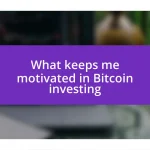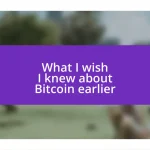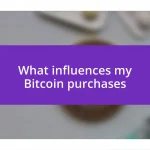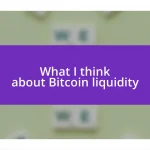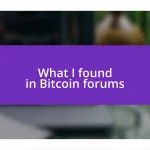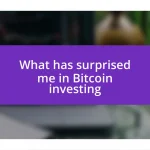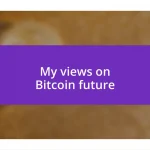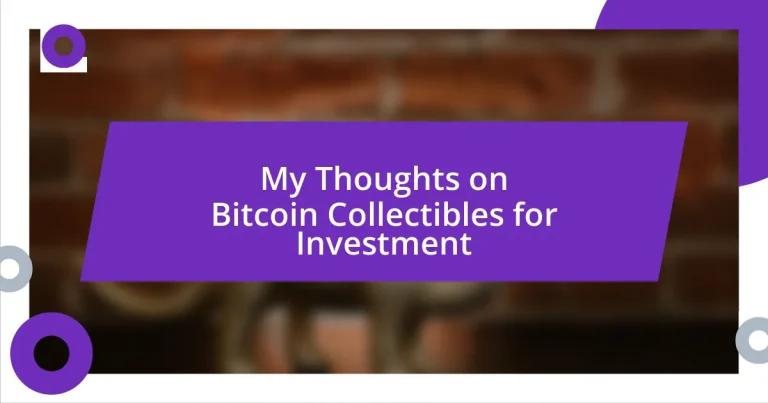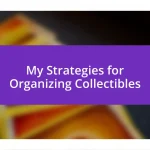Key takeaways:
- Bitcoin collectibles, including NFTs, blend digital currency and art, driven by emotional connections and market intrigue.
- Understanding Bitcoin as an asset involves recognizing its limited supply, digital ownership, market volatility, and potential for global reach.
- Future trends indicate increased integration with technologies like AR, fractional ownership, and metaverse platforms, enhancing accessibility and engagement in collectibles.

Introduction to Bitcoin Collectibles
Bitcoin collectibles, also known as crypto collectibles or NFTs (non-fungible tokens), represent a fascinating intersection between digital currency and art. When I first stumbled upon these unique assets, I was both intrigued and a bit skeptical. How could something that exists only in a digital format hold real value? This question lingered in my mind as I explored the world of blockchain technology and its applications.
One particular moment stands out: I attended an online auction featuring digital art tied to Bitcoin. Watching collectors enthusiastically bid on these pieces made me realize that the emotional connection people have with digital collectibles is powerful. It’s more than just a transaction; it’s about owning a piece of digital history that can’t be replicated. This emotional aspect often drives the market, making investment in Bitcoin collectibles such a captivating prospect.
As I began to learn more about this landscape, I found myself wondering about the long-term potential of these assets. Can they retain their value as the market evolves? For me, this exploration has been as much about understanding technology as it is about grasping human behavior and the concept of ownership in the digital age.
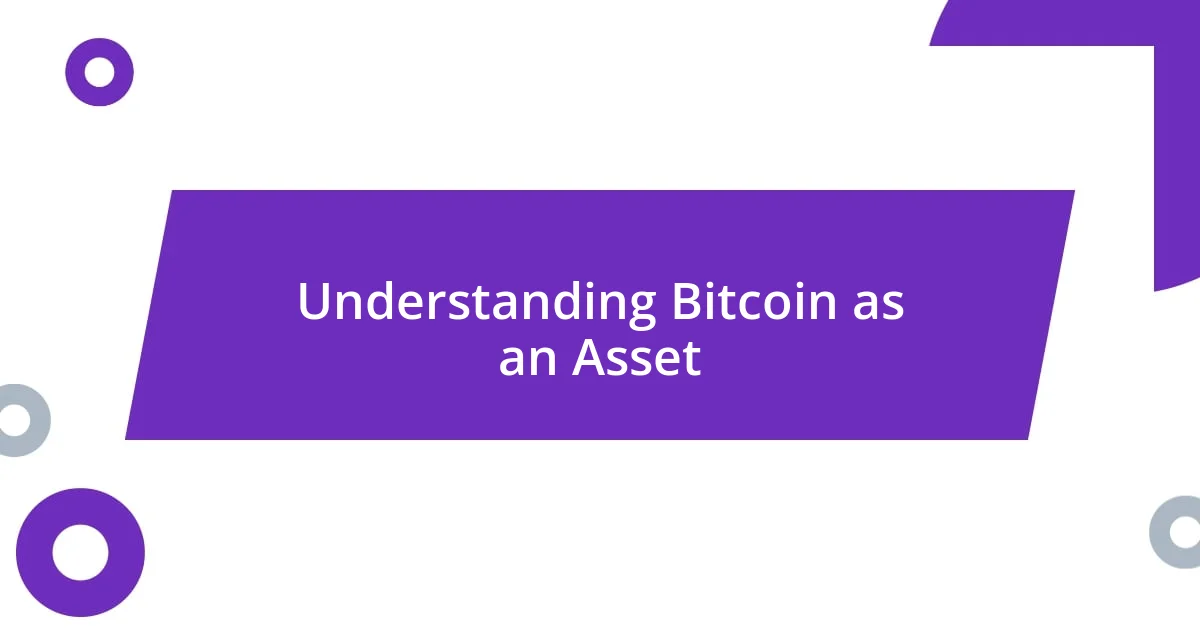
Understanding Bitcoin as an Asset
Bitcoin, as an asset, has opened doors that traditional investments simply can’t. My own journey into understanding Bitcoin made me appreciate its decentralized nature, which allows for ownership without the need for intermediaries like banks. This shift in control can be incredibly empowering, yet it also raises questions about the volatility inherent in the cryptocurrency market.
Here are some key aspects to consider when thinking of Bitcoin as an asset:
- Limited Supply: Only 21 million Bitcoins will ever exist, creating scarcity comparable to precious metals.
- Digital Ownership: The blockchain ensures that each Bitcoin and its history of ownership is securely recorded, giving an undeniable proof of authenticity.
- Market Volatility: Bitcoin prices can swing dramatically, offering both high potential returns and significant risks.
- Investment Diversification: As a unique asset class, Bitcoin can diversify an investment portfolio, potentially offsetting losses in traditional assets.
- Global Reach: Bitcoin transcends geographical boundaries, allowing for a global market that can facilitate investments from anywhere in the world.
I remember discussing Bitcoin with a close friend who’s a seasoned investor. He pointed out how Bitcoin challenges conventional financial wisdom, and that intrigued me. The idea of a digital gold, reminiscent of how gold was once hoarded for its perceived value, struck a chord with me. It wasn’t just about its price but about the revolutionary concept of ownership and how it reshapes our financial landscape.
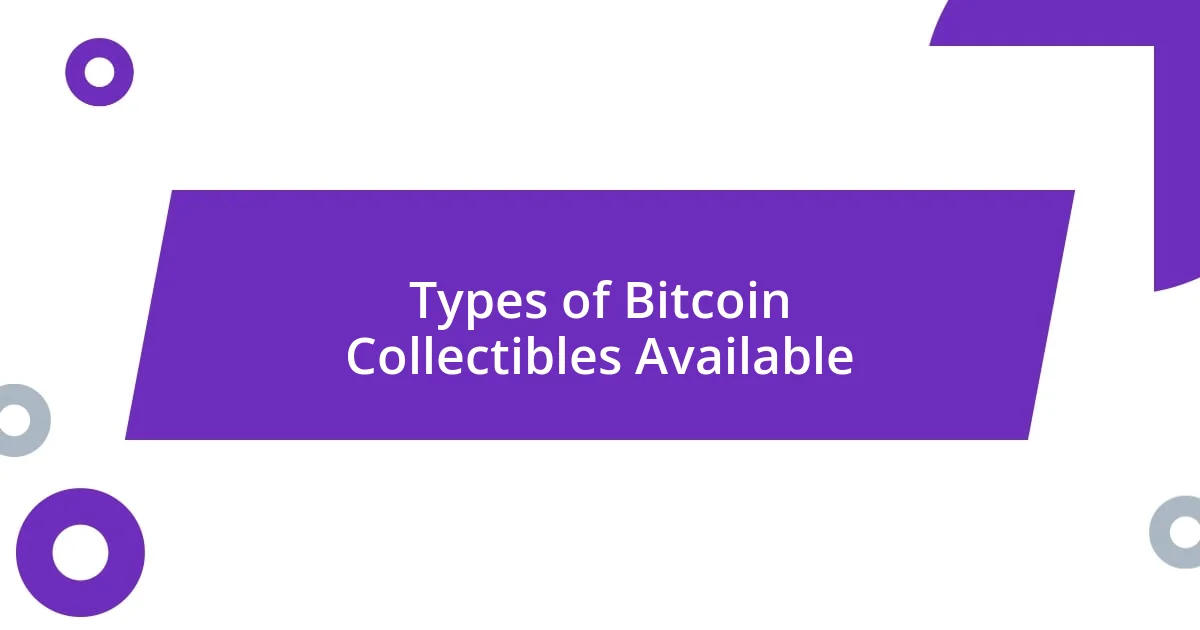
Types of Bitcoin Collectibles Available
Bitcoin collectibles come in various forms, each offering unique opportunities for enthusiasts and investors. One of the most popular types is digital artwork or NFTs. When I first came across these digital pieces, I was amazed at how artists could sell art as unique tokens on the blockchain. It’s like owning a limited edition painting, but in a digital format. This idea that a piece of art could be verified and purchased online felt revolutionary to me.
Another interesting category is virtual real estate in virtual worlds like Decentraland. I vividly recall my friend sharing his experience of bidding on virtual land at a blockchain auction. He described the excitement of owning a parcel in a digital city, where he could hang virtual art or host events. This blend of gaming and investment showcases a new frontier of collectibles that many are excited to explore.
Lastly, there are rare Bitcoin-themed memorabilia, such as physical coins or signed prints. I once attended a meetup where collectors showcased these items, and the passion in that room was palpable. Seeing Bitcoin represented in such tangible forms made me reflect on how the digital world can manifest physically, creating a connection between the two realms.
| Type | Description |
|---|---|
| Digital Artwork (NFTs) | Unique pieces of art verified on the blockchain. |
| Virtual Real Estate | Properties in virtual worlds that can be bought, sold, and developed. |
| Memorabilia | Physical items representing Bitcoin, like coins and signed prints. |
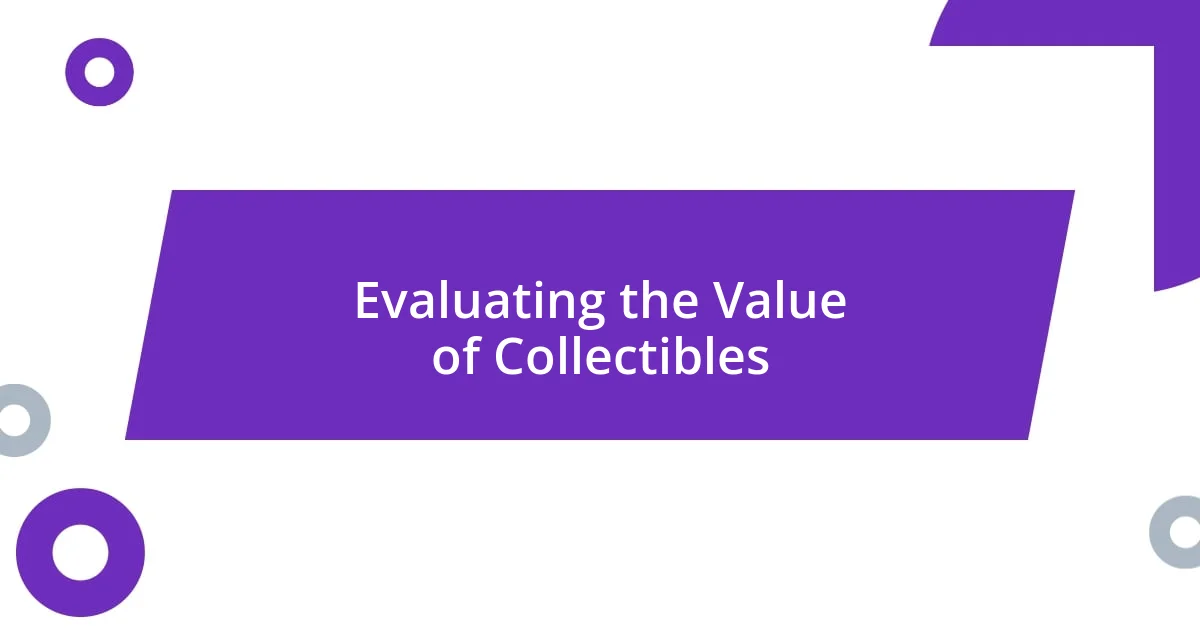
Evaluating the Value of Collectibles
Understanding the value of collectibles is crucial, and I often think about how much joy they can bring beyond mere investment. When I attended a local cryptocurrency event, I spoke with a collector who shared how their passion for Bitcoin artwork transformed into a tangible financial asset. It made me realize that the personal connection to a collectible can sometimes outweigh its market value. Is it possible that emotional attachment can drive worth just as much as supply and demand?
When it comes to evaluating Bitcoin collectibles, rarity plays a decisive role. I remember diving deep into my first NFT purchase; it was not only about its price but also the story behind it that captivated me. The artistry and the artist’s vision, combined with how few tokens existed, significantly enhanced its value in my eyes. This sparked a thought: could the narrative behind a collectible be the key to unlocking its true potential on the market?
Another aspect to consider is authenticity, which is firmly established through blockchain technology. I once marveled at how easily I could verify the provenance of a digital artwork, ensuring that it was one of a kind. This layer of trust made me appreciate my investment even more, knowing that I owned something legitimate. The question lingers, though: as the market evolves, how will we continue to assess the authenticity and value of new types of collectibles emerging from this innovative space?

Strategies for Investing in Collectibles
When it comes to strategies for investing in collectibles, I find that patience is often overlooked. I remember my early days of collecting Bitcoin-related items; I was eager to jump on trends, often leading to impulsive purchases. Over time, I’ve learned the importance of waiting for the right opportunity, allowing market factors to reveal which collectibles genuinely hold long-term potential. Isn’t it fascinating how a little patience can turn a so-so collection into a treasure trove?
Another effective approach is diversifying your collectible portfolio. Just as with traditional investments, spreading your risk across different types of Bitcoin collectibles can yield better results. For example, instead of just focusing on NFTs, I ventured into virtual real estate and memorabilia. When my NFT’s value fluctuated, I felt secure knowing my other investments helped cushion the impact. Doesn’t it make sense to have your eggs in multiple baskets?
Engaging with the community can also provide valuable insights for any collector. During a local meetup, I struck up a conversation with seasoned collectors who shared their strategies and lessons learned, which often made a more significant impact than getting advice from articles. The support and knowledge exchange truly made me appreciate the camaraderie within this niche. Have you ever experienced that kind of exchange and felt inspired to refine your own approach?
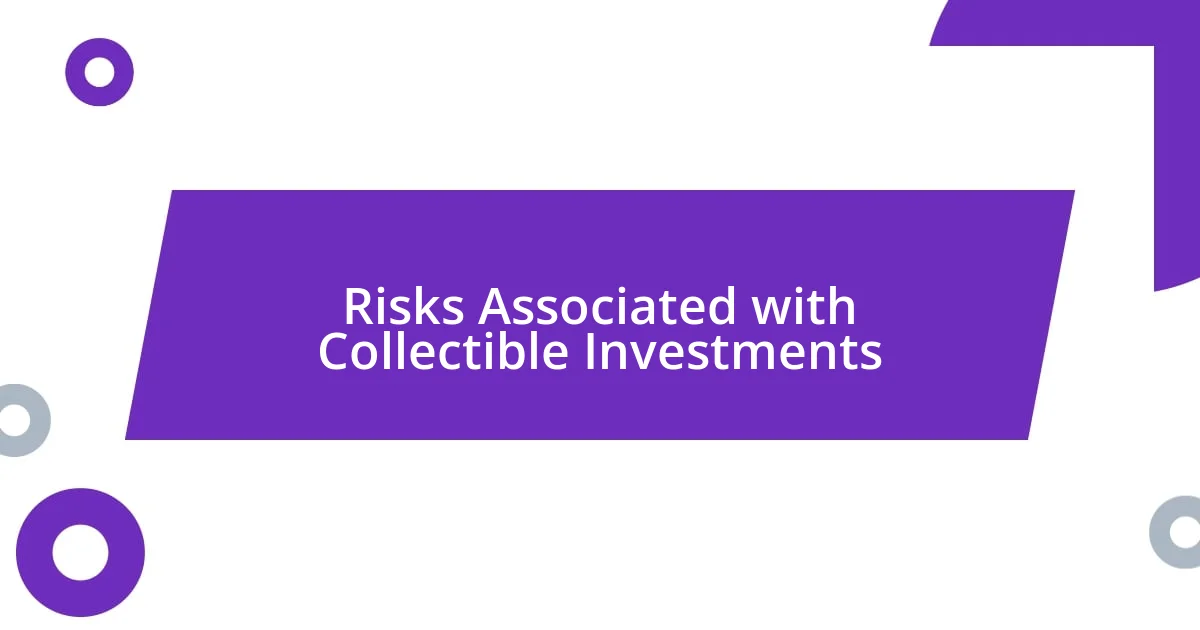
Risks Associated with Collectible Investments
Engaging in collectible investments is not without its risks. I’ve seen firsthand how market volatility can impact the value of collectibles, particularly with Bitcoin-related items. It can feel disheartening when an asset that once seemed promising suddenly declines in value — have you ever felt that wave of uncertainty? I sure have, and it’s a reminder that what goes up can just as easily come down.
Another significant risk is market saturation. As I navigated the NFT space, I noticed an influx of new items flooding the market. While variety can be exciting, it also raises questions about how many truly unique and valuable pieces exist. I often found myself wondering: at what point does the abundance of options dilute the value of exceptional collectibles? This experience taught me to tread carefully before diving into the latest trends.
Additionally, liquidity can be a major concern for collectors. I recall trying to sell a digital piece that I believed had considerable worth, but it took longer than expected to find a buyer. That situation forced me to confront an uncomfortable truth: just because something is rare doesn’t mean it’s easy to sell. Have you ever faced a situation where you realized that investing in collectibles isn’t as simple as flipping a switch?
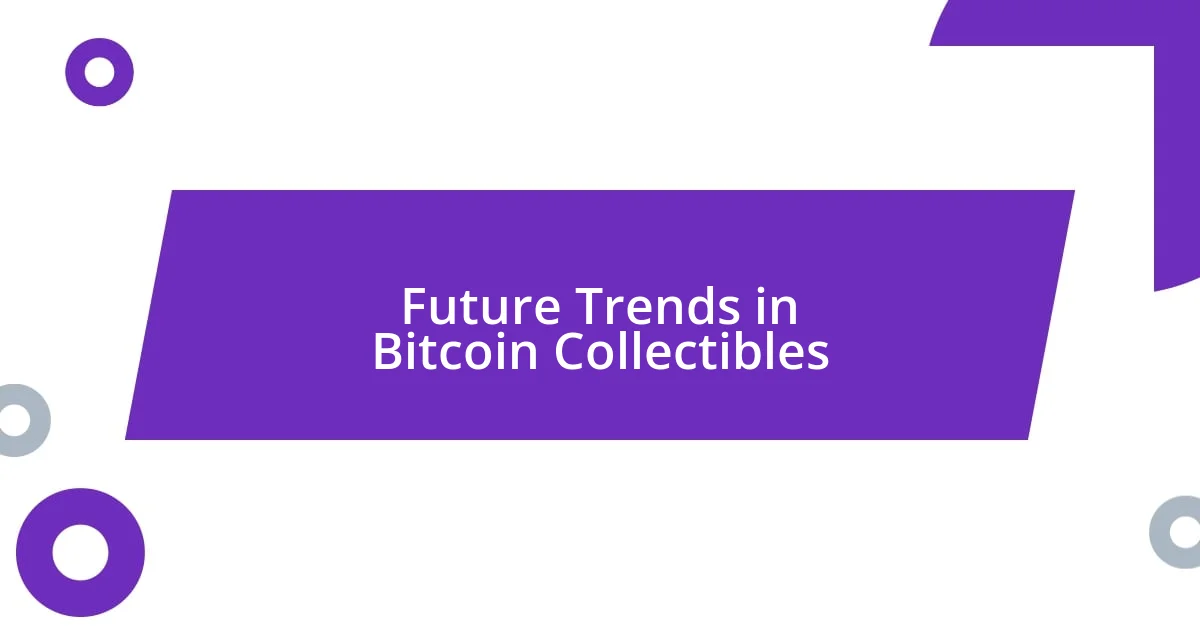
Future Trends in Bitcoin Collectibles
As I look ahead, I can’t help but get excited about the increasing intersection of Bitcoin collectibles with augmented reality (AR) technology. Imagine walking through a gallery where you can view your NFT collection in immersive 3D or even interact with them in real-time. I experienced a demo of an AR app once, and it opened my eyes to how technology could enhance the ownership experience of digital collectibles. Could this be the future of displaying our prized investments?
Moreover, I see a growing trend in fractional ownership of high-value Bitcoin collectibles. This concept allows more people to invest in expensive items by purchasing shares rather than the whole piece. I’ve spoken to friends who struggled to justify the purchase of a high-end NFT but found solace in the idea of owning a fraction of it. Doesn’t this democratization of investment make collectibles more accessible for collectors like us?
Lastly, I anticipate that integration with metaverse platforms will redefine how we engage with Bitcoin collectibles. I remember exploring a metaverse event where NFTs were bought, sold, and displayed in virtual spaces. It was exhilarating to see how the digital realm could create new avenues for social interaction and commerce. Are we on the brink of an explosion in collectors organizing in these virtual environments? I’m eager to see how these trends will transform our collecting experiences and investment strategies in the near future.

